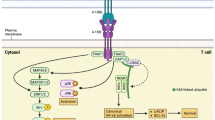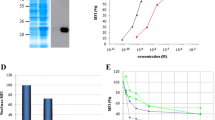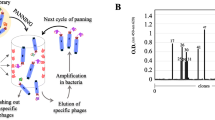Abstract
Immunotoxins with selective cytotoxicity are frequently used as therapeutic immunosuppressive agents in solid-organ transplantation because of their efficiency and high specificity. In this study, we present a new recombinant immunotoxin termed anti-CTLA-4-scFv–melittin prepared from Escherichia coli aimed at clearing activated T cells at the same time avoiding all-round decline in systematic immunity. This fusion protein is composed of anti-CTLA-4-scFv unit and melittin analog unit with properties of low immunogenicity and selective cytotoxicity to CTLA-4-positive T cells. In preliminary biological activity assays, our results confirmed the feasibility of activated T cell clearance strategy and there were significant differences in cell survival rates between CTLA-4-positive group and control group at all experimental concentrations of the immunotoxin. The selective cytotoxicity, low immunogenicity, and low production cost make it an attractive alternate to traditional immunosuppressants.







Similar content being viewed by others
References
Stemer, G., & Lemmens-Gruber, R. (2010). Clinical pharmacy services and solid organ transplantation: a literature review. Pharmacy World & Science, 32, 7–18.
Sigal, L. H. (2012). Basic science for the clinician 55: CTLA-4. Journal of Clinical Rheumatology, 18, 155–158.
Jain, N., Nguyen, H., Chambers, C., & Kang, J. (2010). Dual function of CTLA-4 in regulatory T cells and conventional T cells to prevent multiorgan autoimmunity. Proceedings of the National Academy of Sciences, 107, 1524–1528.
Salama, April K. S., & Stephen Hodi, F. (2011). Cytotoxic T-Lymphocyte -Associated Antigen-4. Clinical Cancer Research, 17, 4622–4628.
Egen, J. G., Kuhns, M. S., & Allison, J. P. (2002). CTLA-4: new insights into its biological function and use in tumor immunotherapy. Nature Immunology, 3, 611–618.
Schneider, H., Downey, J., Smith, A., Zinselmeyer, B. H., Rush, C., Brewer, J. M., et al. (2006). Reversal of the TCR stop signal by CTLA-4. Science, 313, 1972–1975.
Guo, J., Si, L., Kong, Y., Flaherty, K. T., Xu, X., Zhu, Y., et al. (2011). Phase II, open-label, single-arm trial of imatinib mesylate in patients with metastatic melanoma harboring c-Kit mutation or amplification. Journal of Clinical Oncology, 29, 2904–2909.
Boni, A., Cogdill, A. P., Dang, P., Udayakumar, D., Njauw, C. N., Sloss, C. M., et al. (2010). Selective BRAFV600E inhibition enhances T-cell recognition of melanoma without affecting lymphocyte function. Cancer Research, 70, 5213–5219.
Habermann, E. (1972). Bee and wasp venoms the biochemistry and pharmacology of their peptides and enzymes are reviewed. Science, 177, 314–322.
Raghuraman, H., & Chattopadhyay, A. (2007). Melittin: a membrane-active peptide with diverse functions. Bioscience Reports, 27, 189–223.
Dempsey, C. E. (1990). The actions of melittin on membranes. Biochimica et Biophysica Acta, 1031, 143–161.
Son, D. J., Lee, J. W., Lee, Y. H., Song, H. S., Lee, C. K., & Hong, J. T. (2007). Therapeutic application of anti-arthritis, pain-releasing, and anti-cancer effects of bee venom and its constituent compounds. Pharmacology & Therapeutics, 115, 246–270.
Readett, DRJ., Jungnelius, JUB., Gomeznovarro, J., Hanson, D., Krieg, AM. (2007). Anti-CTLA-4 antibody and CpG-Motif-contanting synthetic oligodeoxynucleotide combination therapy for cancer treatment. WO 2007/008463 A2 [P], 1–18.
Zhao, Y. H., Bai, B. Y., Liu, A. S., Gao, X. Y., & Lin, J. R. (2008). Gene expression and structure-activity relationship of melittin analogues. Journal of South China University of Technology (Natural Science)., 12, 116–120.
Nelson, M. D., & Fitch, D. H. (2011). Overlap extension PCR: an efficient method for transgene construction. Methods in Molecular Biology, 772, 459–470.
Pistillo, M. P., Tazzari, P. L., Palmisano, G. L., Pierri, I., Bolognesi, A., Ferlito, F., et al. (2003). CTLA-4 is not restricted to the lymphoid cell lineage and can function as a target molecule for apoptosis induction of leukemic cells. Blood, 101, 202–209.
Coelho, T., Tredger, M., & Dhawan, A. (2012). Current status of immunosuppressive agents for solid organ transplantation in children. Pediatric Transplantation, 16, 106–122.
Rudd, C. E., Taylor, A., & Schneider, H. (2009). CD28 and CTLA-4 coreceptor expression and signal transduction. Immunology Reviews, 229, 12–26.
Bolognesi, A., Polito, L., Tazzari, P., Lemoli, R. M., Lubelli, C., Fogli, M., et al. (2000). In vitro anti-tumor activity of anti-CD80 and anti-CD86 immunotoxins containing type 1 ribosome-inactivating proteins. British Journal of Haematology, 110, 351–361.
Weetall, M., Digan, M. E., Hugo, R., Mathew, S., Hopf, C., Tart-Risher, N., et al. (2002). T-cell depletion and graft survival induced by anti-human CD3 immunotoxins in human CD3 epsilon transgenic mice. Transplantation, 73, 1658–1666.
Asiedu, C. K., Goodwin, K. J., Balgansuren, G., Jenkins, S. M., Le Bas-Bernardet, S., Jargal, U., et al. (2005). Elevated T regulatory cells in long-term stable transplant tolerance in rhesus macaques induced by anti-CD3 immunotoxin and deoxyspergualin. Journal of Immunology, 175, 8060–8068.
Tazzari, P. L., Polito, L., Bolognesi, A., Pistillo, M. P., Capanni, P., Palmisano, G. L., et al. (2001). Immunotoxins containing recombinant anti-CTLA-4 single-chain fragment variable antibodies and saporin: in vitro results and in vivo effects in an acute rejection model. Journal of Immunology, 167, 4222–4229.
Pistillo, M. P., Tazzari, P. L., Ellis, J. H., & Ferrara, G. B. (2000). Molecular characterization and applications of recombinant scFv antibodies to CD 152 co-stimulatory molecule. Tissue Antigens, 55, 229–238.
Zeng, L., Wan, L., Chen, L., Li, S., Lu, Y., Huang, Q., et al. (2006). Selective depletion of activated T Cells by recombinant immunotoxin containing anti-CTLA-4 single-chain fragment of variable antibody and N-terminal fragment of perforin. Transplantation Proceedings, 38, 2151–2153.
Hagemeyer, C. E., von Zur, M. C., Von Elverfeldt, D., & Peter, K. (2009). Single-chain antibodies as diagnostic tools and therapeutic agents. Thrombosis and Haemostasis, 101, 1012–1019.
Oršolić, N. (2012). Bee venom in cancer therapy. Cancer Metastasis Reviews, 31, 173–194.
Conflict of interest
The authors report no conflict of interest.
Author information
Authors and Affiliations
Corresponding author
Additional information
Hailong Jin, Congran Li and Ding Li contributed equally to this study.
Rights and permissions
About this article
Cite this article
Jin, H., Li, C., Li, D. et al. Construction and Characterization of a CTLA-4-Targeted scFv–Melittin Fusion Protein as a Potential Immunosuppressive Agent for Organ Transplant. Cell Biochem Biophys 67, 1067–1074 (2013). https://doi.org/10.1007/s12013-013-9605-9
Published:
Issue Date:
DOI: https://doi.org/10.1007/s12013-013-9605-9




